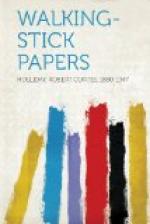Bivens next answered an advertisement for a strike-breaker to light street lamps, and for a person to distribute handbills at a pay of seventy-five cents a day. But his luck had changed; he never got another reply to any answer to a help-wanted “ad.”
He thinks this is strange, because he believes (and I know this is true) that he writes a letter which would instantly mark him as a man of high merit among the multitude.
But I once knew a man who put a help-wanted “ad” in the paper. He ran a hotel, and he advertised for a clerk. I was stopping at his place at the time, I and my three brothers. And the five of us, Mr. Snuvel (the hotel man), I, and my three brothers, used to bring up from the village every night for a week (the place was in the country) the mail, which consisted of replies to this help-wanted advertisement. We used large sacks for this purpose.
XVI
HUMAN MUNICIPAL DOCUMENTS
A literary adventurer not long since found himself, by one of the exigencies incident to his precarious career, turning over in the process of cataloguing a kind of literature in which up to that time he had been very little read, a public collection of published municipal documents. This gentleman had had a notion for a good many years that municipal documents were entirely for very serious people engaged in some useful undertakings. He had never conceived of them as works of humour and objects of art. But his disinclination to this department of pure literature was dissolved, as most prejudices may be, by acquaintance with the subject.
Municipal documents are human documents. They are the autobiographies of communities. The personalities of Topeka, Kansas, of Limoges, France, and of Heidelberg, Germany, rise before the impressionable student of municipal documents like the figures of personal autobiography, like Benvenuto Cellini, Marie Bashkirtsev, Benjamin Franklin, Miss Mary Maclane, Mr. George Moore.
A very touching quality in municipal documents is their naivete—that unavoidable and unconscious self-revelation which is much of the great charm and value of all autobiographies. By the way, do statisticians really understand municipal documents, or do they think them valuable simply because they are full of statements of fact?
Our literary gentleman, at all events, found his task very engaging, though as a cataloguer he was much perplexed by the extraordinary informality, in one respect, of formal public papers, a curious provinciality, as he could but take it to be, of municipalities. A very common neglect, he found, in such publications is to make any mention anywhere of the relation to geography of the community chronicling its history.




